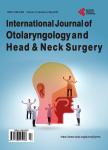Failure Rate of Adenoidectomy and Reasons of Failure in the Short Term
腺样体切除术,并在短期内失效原因的故障率作者机构:Otorhinolaryngology ClinicsInegol Government HospitalBursaTurkey Department of OtorhinolaryngologyMedical FacultyUludag UniversityBursaTurkey
出 版 物:《International Journal of Otolaryngology and Head & Neck Surgery》 (耳鼻喉(英文))
年 卷 期:2012年第1卷第2期
页 面:14-17页
学科分类:1002[医学-临床医学] 100214[医学-肿瘤学] 10[医学]
主 题:Adenoidectomy Nasal Obstruction Snoring
摘 要:Objectives: The aim of the present study was to analyze the recovery rate of symptoms in patients with adenoid hypertrophy and investigate the role of nasal pathologies, allergy and gastroesophageal reflux (GER) as the reason of failure in patients with persistent symptoms. Patients and Methods: Patients undergoing adenoidectomy were enrolled in this study. There were 58 males and 42 females, aged between 1 - 13 years (mean ± SD: 4.9 ± 2.2 years). The parents of each child were questioned about the following symptoms;apnea, nasal obstruction, mouth breathing, snoring and nasal discharge. Presence or absence of nasal obstruction due to septal deviation and/or chonchal hypertrophy was noted. All children were evaluated for GER by upper gastrointestinal endoscopy or pH monitorization and for allergy by specific IgE analysis or skin prick test. Three months after the operation the children were re-examined and their parents were interviewed about persistent symptoms. Patients with persistent symptoms were re-evaluated with rigid endoscopy for residual adenoid vegetation. Results: Apnea was cleared in the entire group postoperatively. However, 9 patients complained of nasal obstruction, 16 patients had mouth breathing, 9 patients had snoring and 17 patients continued to have nasal discharge two months after the operation. Statistical assessment showed a significant difference for each symptom between the pre- and postoperative level (p Conclusions: Adenoidectomy alone is an effective treatment for nasal obstruction and obstructive sleep symptoms in children. Persistent obstructive symptoms are usually due to nasal pathology and allergy.



